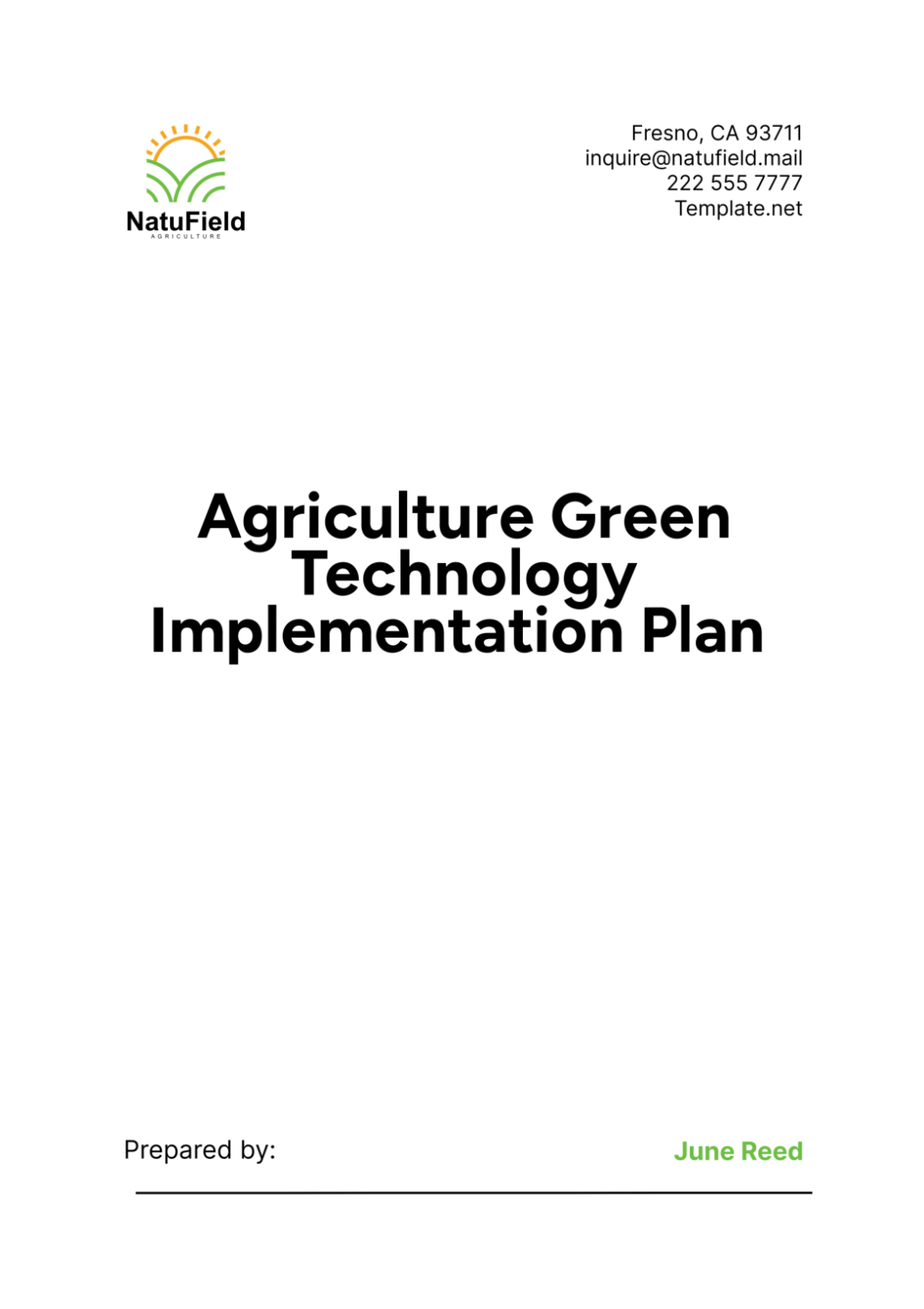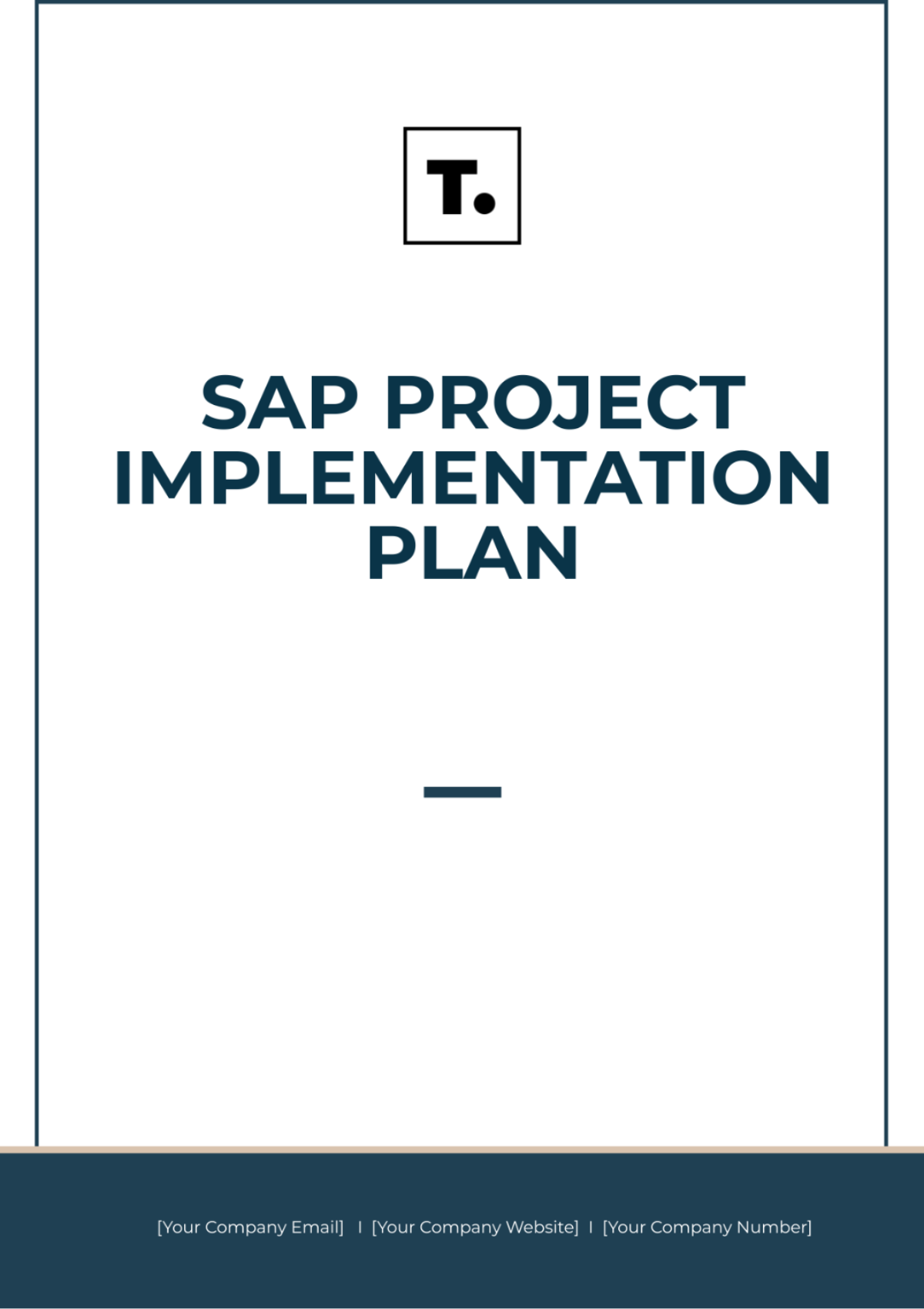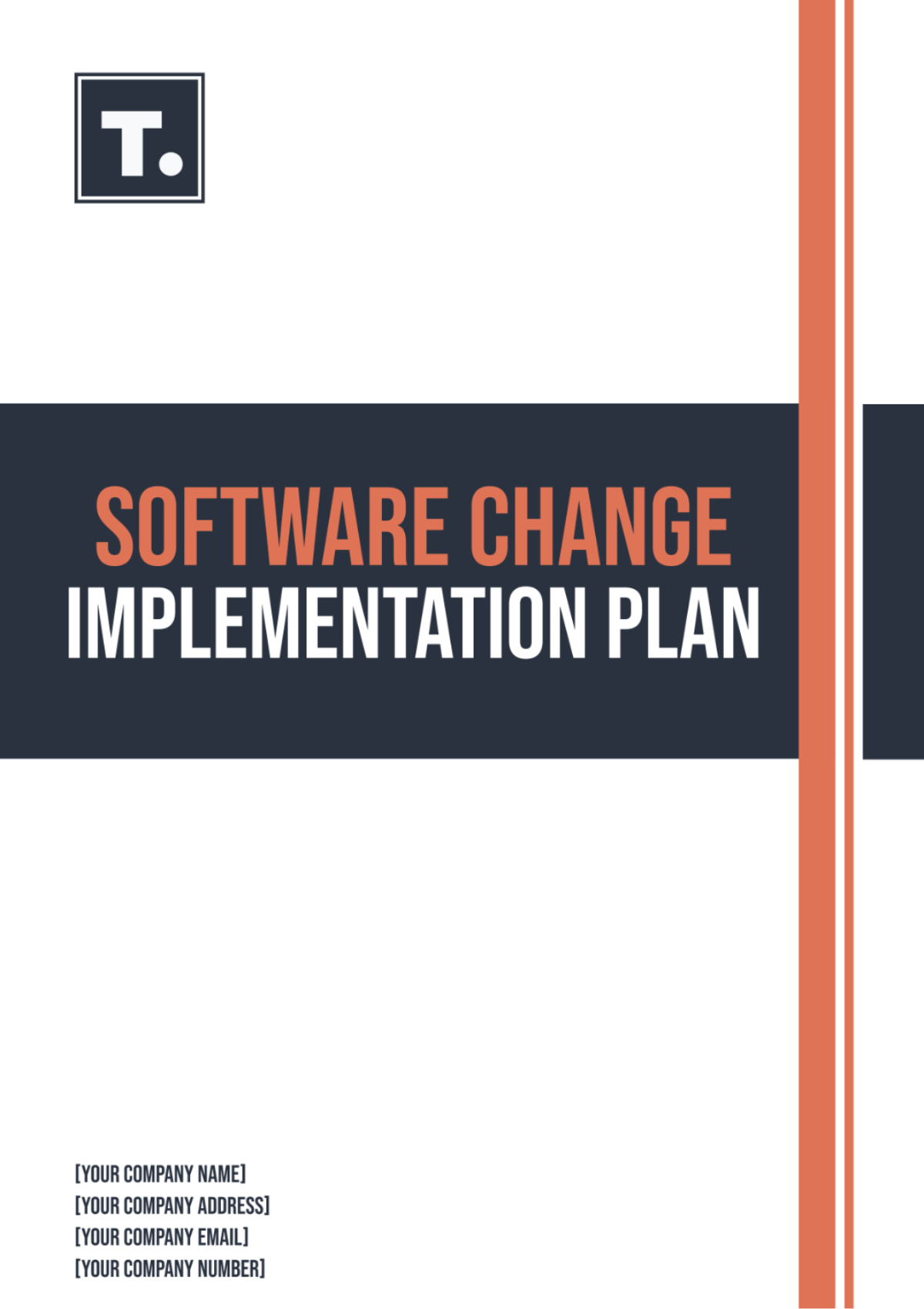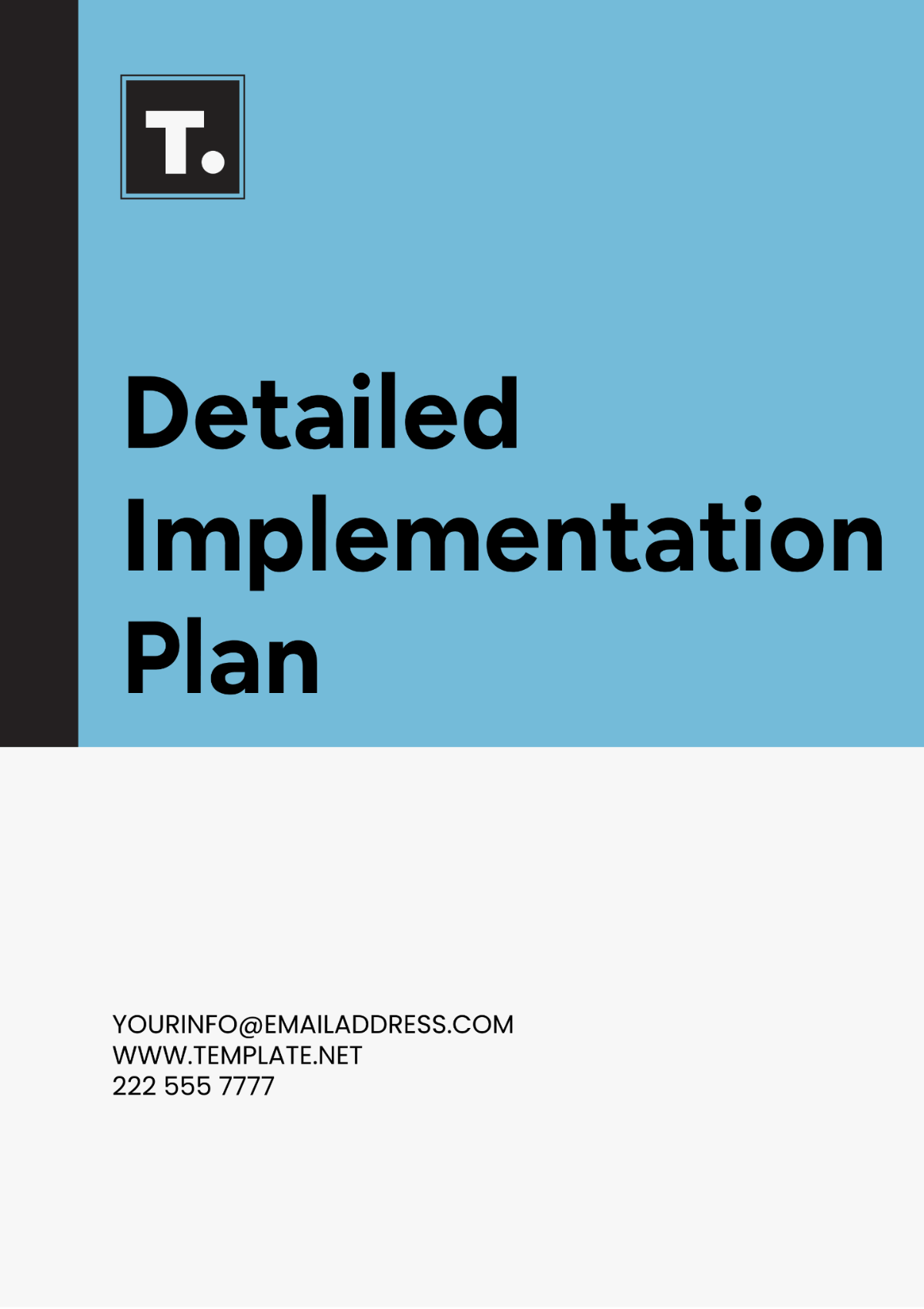Agriculture Green Technology Implementation Plan
I. Overview
The Agriculture Green Technology Implementation Plan by [Your Company Name] aims to transform our farming practices into more sustainable and environmentally friendly operations. This plan outlines the strategic approach to integrating advanced green technologies to enhance productivity while reducing the environmental footprint. By adopting these innovative solutions, we seek to ensure the long-term viability of our agricultural operations and contribute to global efforts in combating climate change.
Implementing green technology in agriculture offers numerous benefits, including improved resource efficiency, enhanced crop yields, and reduced environmental impact. This plan details the steps necessary to achieve these benefits through a comprehensive strategy tailored to the unique needs and challenges of [Your Company Name].
II. Introduction
A. Background Information
Green technology in agriculture encompasses a range of practices and innovations designed to increase efficiency and sustainability. These technologies include renewable energy sources, precision farming techniques, water conservation methods, and organic farming practices. As the global population continues to grow, the demand for food increases, placing additional pressure on agricultural systems. Green technology provides a viable solution to meet this demand while preserving natural resources and minimizing environmental degradation.
B. Importance and Relevance
For [Your Company Name], the adoption of green technology is not only a strategic move but also a moral imperative. Traditional farming methods often lead to soil depletion, water scarcity, and increased greenhouse gas emissions. By transitioning to green technologies, we can mitigate these negative impacts and set an example for sustainable agricultural practices. This shift aligns with our commitment to environmental stewardship and corporate social responsibility, positioning us as a leader in sustainable agriculture.
III. Objectives
A. Specific Objectives
The primary objectives of the Agriculture Green Technology Implementation Plan for [Your Company Name] are as follows:
Reduce Environmental Impact: Minimize the carbon footprint and environmental degradation associated with conventional farming practices.
Enhance Resource Efficiency: Optimize the use of water, energy, and other inputs to increase overall efficiency and reduce waste.
Improve Crop Yields: Utilize advanced technologies to boost crop productivity and quality.
Promote Sustainable Practices: Encourage the adoption of sustainable farming techniques among our workforce and stakeholders.
Ensure Long-term Viability: Establish a foundation for continued innovation and sustainability in our agricultural operations.
B. Long-term and Short-term Goals
Short-term Goals:
Conduct a comprehensive assessment of current agricultural practices.
Identify and select suitable green technologies for initial implementation.
Launch pilot projects to test the effectiveness of selected technologies.
Long-term Goals:
Achieve full-scale implementation of green technologies across all farming operations.
Establish a continuous improvement framework to integrate new advancements in green technology.
Promote widespread adoption of sustainable practices within the agricultural community.
IV. Current Agricultural Practices
A. Overview of Current Practices
Currently, [Your Company Name] employs a mix of traditional and modern farming techniques. While these methods have been effective in ensuring consistent production, they also present several challenges and limitations. Conventional practices often rely heavily on chemical fertilizers and pesticides, which can lead to soil degradation, water contamination, and adverse health effects.
B. Areas Needing Improvement
Several areas within our current agricultural practices require improvement:
Water Usage: Inefficient irrigation systems result in significant water waste and reduced crop yields.
Soil Health: Continuous use of chemical fertilizers and monocropping practices have degraded soil quality, reducing its fertility and productivity.
Energy Consumption: Reliance on fossil fuels for machinery and irrigation pumps increases our carbon footprint and operational costs.
Waste Management: Improper disposal of agricultural waste contributes to environmental pollution and resource inefficiency.
C. Environmental Impact of Current Practices
The environmental impact of our current farming practices is significant. Excessive use of chemical inputs has led to soil and water pollution, while inefficient irrigation methods contribute to water scarcity. Furthermore, the reliance on non-renewable energy sources exacerbates greenhouse gas emissions, contributing to climate change. Addressing these issues through the implementation of green technology is crucial for creating a more sustainable and resilient agricultural system.
V. Green Technology Solutions
A. Solar-powered Irrigation Systems
Solar-powered irrigation systems harness solar energy to power water pumps, providing an efficient and sustainable solution for crop irrigation. By utilizing photovoltaic panels, these systems convert sunlight into electricity, reducing reliance on fossil fuels and lowering operational costs. Additionally, solar-powered irrigation helps mitigate water waste through precise control and distribution, enhancing water use efficiency.
B. Organic Farming Techniques
Organic farming emphasizes the use of natural inputs and sustainable practices to maintain soil health and ecosystem balance. Techniques such as composting, crop rotation, and the use of organic fertilizers and pest control methods reduce chemical dependency and improve soil fertility. Organic farming not only produces healthier crops but also enhances biodiversity and promotes a more resilient agricultural system.
C. Biofertilizers and Biopesticides
Biofertilizers and biopesticides are natural alternatives to chemical fertilizers and pesticides. Derived from living organisms, these products enhance soil fertility and provide effective pest control without the harmful side effects of synthetic chemicals. Biofertilizers improve nutrient availability and uptake, while biopesticides target specific pests, reducing the risk of resistance and environmental contamination.
D. Precision Farming
Precision farming utilizes advanced technologies such as GPS, sensors, and data analytics to optimize agricultural practices. By collecting and analyzing real-time data, precision farming allows for precise application of inputs, reducing waste and enhancing productivity. Techniques such as variable rate application and remote sensing enable farmers to make informed decisions, resulting in higher yields and more efficient resource use.
E. Drip Irrigation
Drip irrigation is a highly efficient water delivery system that provides water directly to the plant roots through a network of tubes and emitters. This method reduces water waste, prevents soil erosion, and ensures uniform distribution of water and nutrients. Drip irrigation is particularly beneficial in arid regions and for crops that require precise water management, contributing to improved crop yields and water conservation.
F. Renewable Energy Sources
Integrating renewable energy sources such as wind and solar power into agricultural operations reduces dependence on non-renewable energy and lowers greenhouse gas emissions. Wind turbines and solar panels can be used to generate electricity for farm machinery, irrigation systems, and processing facilities, creating a sustainable and cost-effective energy solution.
G. Water Conservation Technologies
Water conservation technologies, including rainwater harvesting and soil moisture sensors, play a critical role in sustainable agriculture. Rainwater harvesting systems collect and store rainwater for agricultural use, reducing reliance on groundwater and enhancing water availability. Soil moisture sensors provide real-time data on soil moisture levels, enabling precise irrigation scheduling and minimizing water waste.
H. Crop Rotation and Polyculture
Crop rotation and polyculture are traditional agricultural practices that promote soil health and biodiversity. Crop rotation involves growing different crops in succession on the same land to prevent soil depletion and reduce pest and disease buildup. Polyculture, the cultivation of multiple crops in the same area, enhances ecosystem resilience, improves soil structure, and increases overall productivity.
VI. Implementation Strategy
A. Initial Assessment and Feasibility Study
The first step in implementing green technologies at [Your Company Name] involves conducting a comprehensive assessment of current agricultural practices. This assessment will identify areas needing improvement and evaluate the feasibility of various green technologies. A feasibility study will analyze factors such as cost, resource availability, and potential benefits, ensuring that selected technologies align with our goals and capabilities.
B. Selection of Suitable Technologies
Based on the assessment and feasibility study, [Your Company Name] will select the most suitable green technologies for implementation. This selection process will consider factors such as environmental impact, cost-effectiveness, ease of integration, and scalability. Technologies that demonstrate the greatest potential for improving resource efficiency and reducing environmental impact will be prioritized.
C. Resource Allocation and Budgeting
Effective implementation requires careful planning and resource allocation. [Your Company Name] will develop a detailed budget outlining the costs associated with each green technology. This budget will include expenses for equipment, installation, training, and maintenance. Resource allocation will ensure that necessary funds are available for successful implementation and ongoing support.
D. Training and Capacity Building for Farmers
Training and capacity building are essential for the successful adoption of green technologies. [Your Company Name] will organize training programs and workshops to educate farmers and staff on the benefits and proper use of selected technologies. These programs will cover topics such as installation, operation, maintenance, and troubleshooting, ensuring that all stakeholders are well-equipped to manage and utilize green technologies effectively.
E. Pilot Projects and Trials
Before full-scale implementation, [Your Company Name] will conduct pilot projects and trials to test the effectiveness of selected green technologies. These pilot projects will provide valuable insights into the practical application, performance, and potential challenges of each technology. Feedback from these trials will inform adjustments and improvements, ensuring that the technologies are well-suited to our specific agricultural context.
F. Scaling Up and Full-scale Implementation
Following the successful completion of pilot projects, [Your Company Name] will proceed with scaling up and full-scale implementation of green technologies. This phase will involve deploying the technologies across all farming operations, monitoring progress, and making necessary adjustments. Continuous support and maintenance will be provided to ensure the long-term success and sustainability of the implemented technologies.
G. Monitoring and Evaluation
A robust monitoring and evaluation framework will be established to track the progress and impact of the green technology implementation. Key performance indicators (KPIs) will be identified to measure the effectiveness of the technologies in achieving our objectives. Regular reporting and reviews will enable us to assess progress, identify areas for improvement, and make informed decisions for future initiatives.
H. Stakeholder Engagement
Engaging stakeholders is crucial for the successful implementation of green technologies. [Your Company Name] will involve key stakeholders, including farmers, government agencies, NGOs, and private sector partners, in the planning and execution of the implementation plan. Collaboration and communication will ensure that all stakeholders are aligned with our goals and contribute to the success of the initiative.
I. Sustainability and Future Plans
Ensuring the long-term sustainability of green technologies is a key priority for [Your Company Name]. Strategies for continuous improvement and innovation will be developed to integrate new advancements and best practices. Future expansion plans will explore opportunities for scaling up successful technologies and promoting widespread adoption within the agricultural community.
VII. Timeline
A. Detailed Timeline
Phase | Activities and Milestones | Timeline |
|---|---|---|
Phase 1: Planning | Conduct feasibility studies and stakeholder consultations | Month 1 - Month 3 |
Identify pilot project sites and finalize selection criteria | Month 2 | |
Phase 2: Preparation | Prepare pilot project sites (infrastructure setup) | Month 3 - Month 4 |
Procure green technologies and equipment | Month 4 | |
Phase 3: Implementation | Install green technologies | Month 5 - Month 6 |
Conduct training sessions for farmers and staff | Month 6 | |
Phase 4: Monitoring | Initiate monitoring and data collection | Ongoing |
Analyze data and prepare interim reports | Month 7 | |
Phase 5: Evaluation | Evaluate pilot project outcomes | Month 8 - Month 9 |
Gather feedback from stakeholders | Month 9 |
B. Milestones and Key Deliverables
Milestone/Deliverable | Description | Expected Completion |
|---|---|---|
Feasibility Study Report | Report outlining the feasibility of green technologies | Month 3 |
Pilot Project Site Selection | Selection of pilot sites based on criteria | Month 2 |
Infrastructure Setup | Completion of infrastructure setup for pilot sites | Month 4 |
Technology Procurement | Purchase and receipt of green technologies | Month 4 |
Installation of Green Technologies | Completion of installation of all selected technologies | Month 6 |
Training Sessions | Conduct training sessions for farmers and operational staff | Month 6 |
Data Collection Initiation | Start of data collection activities | Month 5 |
Interim Reports | Preparation and submission of interim progress reports | Month 7 |
Pilot Project Evaluation | Completion of evaluation of pilot project outcomes | Month 9 |
VIII. Full-scale Implementation
A. Scaling Up Strategies
Once pilot projects demonstrate the effectiveness and feasibility of green technologies, [Your Company Name] will proceed with scaling up these technologies across all farming operations. Scaling up strategies will include:
Phased Implementation: Roll out the technologies in phases, starting with regions or crops that showed the highest potential during pilot projects.
Resource Allocation: Allocate necessary resources, including funding, equipment, and personnel, to support the scaling-up process.
Partnerships and Collaboration: Collaborate with government agencies, NGOs, and private sector partners to leverage additional resources and expertise.
Continuous Monitoring: Continue to monitor the performance of the technologies and make necessary adjustments to optimize their effectiveness.
B. Training and Support
Training and support are essential for the successful adoption of green technologies. [Your Company Name] will:
Develop Training Programs: Create comprehensive training programs covering the operation, maintenance, and troubleshooting of the technologies.
Capacity Building Workshops: Organize workshops and seminars to build the capacity of farmers and staff.
Technical Support: Provide ongoing technical support through a dedicated helpdesk and field visits by experts.
Knowledge Sharing: Facilitate knowledge sharing and best practices through regular meetings and online platforms.
C. Resource Management
Effective resource management is crucial for the success of full-scale implementation. [Your Company Name] will:
Budget Planning: Develop a detailed budget outlining the costs associated with scaling up green technologies.
Resource Allocation: Ensure adequate allocation of financial, human, and technical resources.
Logistics Management: Coordinate logistics for the procurement, transportation, and installation of equipment.
Risk Management: Identify potential risks and develop mitigation strategies to address them.
IX. Sustainability and Future Plans
A. Continuous Improvement
Sustainability requires a commitment to continuous improvement. [Your Company Name] will:
Regular Reviews: Conduct regular reviews of the green technologies to assess their performance and identify areas for improvement.
Innovation and Research: Invest in research and development to explore new and emerging green technologies.
Feedback Mechanism: Establish a robust feedback mechanism to gather input from stakeholders and incorporate their suggestions into future plans.
Adoption of Best Practices: Stay updated with industry best practices and incorporate them into our operations.
B. Long-term Vision
Our long-term vision for sustainable agriculture includes:
Zero Carbon Footprint: Achieve a zero-carbon footprint by integrating renewable energy sources and reducing greenhouse gas emissions.
Resource Efficiency: Optimize the use of water, energy, and other inputs to maximize efficiency and minimize waste.
Biodiversity Conservation: Promote biodiversity through sustainable farming practices and the preservation of natural habitats.
Community Engagement: Engage with local communities to promote sustainable agriculture and improve livelihoods.
X. Cost Analysis and Budgeting
A. Initial Investment
Implementing green technologies requires a significant initial investment. The cost analysis will include:
Technology Costs: The cost of purchasing and installing green technologies such as solar panels, precision farming equipment, and water conservation systems.
Infrastructure Development: Costs associated with developing the necessary infrastructure, including irrigation systems and storage facilities.
Training and Capacity Building: Expenses for training programs, workshops, and technical support.
Monitoring and Evaluation: Costs related to monitoring and evaluation activities, including data collection and analysis.
B. Operational Costs
Operational costs include ongoing expenses for maintaining and operating green technologies. These costs will cover:
Maintenance and Repairs: Regular maintenance and repairs to ensure the technologies remain functional.
Energy Costs: Although renewable energy sources reduce energy costs, there may still be expenses associated with their operation.
Labor Costs: Salaries for personnel involved in the implementation and monitoring of green technologies.
Miscellaneous Expenses: Other expenses such as transportation, logistics, and administrative costs.
C. Cost-benefit Analysis
A cost-benefit analysis will be conducted to evaluate the financial viability of implementing green technologies. This analysis will consider:
Initial Investment vs. Long-term Savings: Compare the initial investment with the long-term savings in operational costs.
Environmental Benefits: Quantify the environmental benefits, such as reduced carbon emissions and improved resource efficiency.
Productivity Gains: Assess the increase in crop yields and quality resulting from the use of green technologies.
Social Impact: Evaluate the social impact, including improved livelihoods for farmers and enhanced community well-being.
XI. Stakeholder Engagement
A. Identification of Key Stakeholders
Stakeholder Category | Description |
|---|---|
Farmers and Staff | Primary beneficiaries and users of green technologies |
Government Agencies | Regulatory bodies and agencies providing support and incentives for sustainable agriculture |
NGOs and Community Organizations | Organizations working on environmental conservation and sustainable agriculture |
Private Sector Partners | Companies providing green technologies and related services |
B. Communication Strategy
Communication Activity | Description |
|---|---|
Information Dissemination | Provide regular updates and information through newsletters, websites, and social media |
Stakeholder Meetings | Organize meetings and workshops to discuss progress, challenges, and solutions |
Feedback Mechanism | Establish a feedback mechanism to gather input and suggestions from stakeholders |
Public Awareness Campaigns | Conduct public awareness campaigns to promote the benefits of green technologies and sustainable agriculture |
C. Collaboration and Partnerships
Collaboration Activity | Description |
|---|---|
Formal Agreements | Establish formal agreements with government agencies, NGOs, and private sector partners |
Joint Projects | Collaborate on joint projects and initiatives to leverage resources and expertise |
Capacity Building | Work with partners to build the capacity of farmers and staff |
Resource Mobilization | Mobilize resources through partnerships to support the implementation plan |
XII. Risk Management
A. Identification of Risks
Risk Category | Description |
|---|---|
Financial Risks | Unforeseen costs and budget overruns |
Technical Risks | Technical challenges and equipment failures |
Environmental Risks | Adverse environmental conditions affecting the performance of green technologies |
Operational Risks | Operational challenges such as lack of skilled personnel and logistical issues |
B. Mitigation Strategies
Mitigation Strategy | Description |
|---|---|
Financial Contingencies | Establish financial contingencies to cover unforeseen costs |
Technical Support | Provide ongoing technical support and training to address technical challenges |
Environmental Monitoring | Monitor environmental conditions and adapt practices accordingly |
Capacity Building | Invest in capacity building to ensure the availability of skilled personnel |
C. Monitoring and Review
Monitoring Activity | Description |
|---|---|
Regular Assessments | Conduct regular assessments to identify new risks and evaluate the effectiveness of mitigation strategies |
Adaptive Management | Adapt management practices based on the results of assessments and feedback from stakeholders |
Documentation and Reporting | Document and report on risk management activities to ensure transparency and accountability |
Stakeholder Involvement | Involve stakeholders in risk management activities to ensure their concerns and suggestions are addressed |
XIII. Conclusion
The Agriculture Green Technology Implementation Plan by [Your Company Name] provides a comprehensive framework for transitioning to sustainable and environmentally friendly farming practices. By adopting advanced green technologies, we aim to enhance resource efficiency, improve crop yields, and reduce our environmental impact. This plan outlines the steps, strategies, and resources required to achieve these goals, ensuring a sustainable and resilient agricultural system for the future.











































